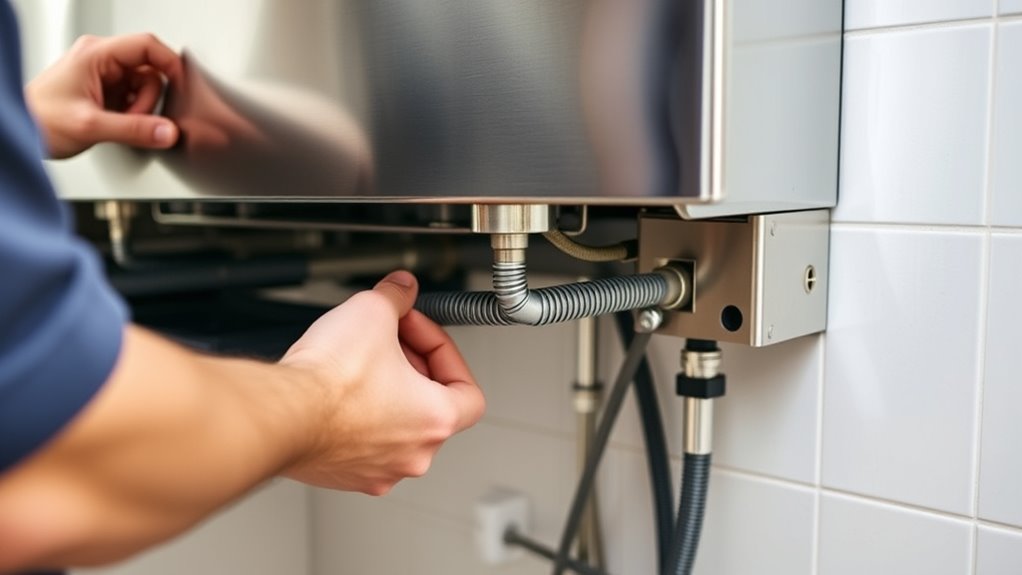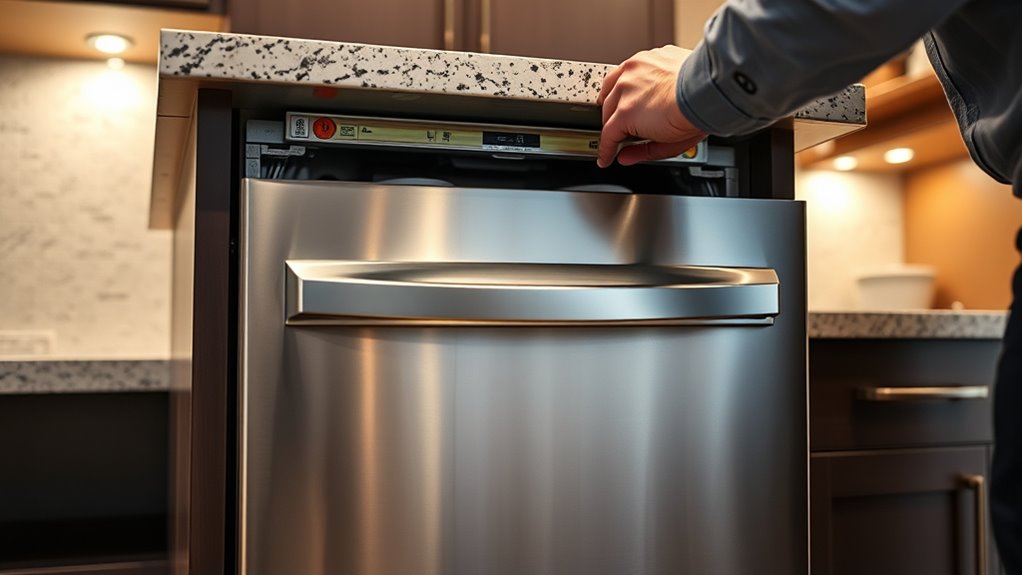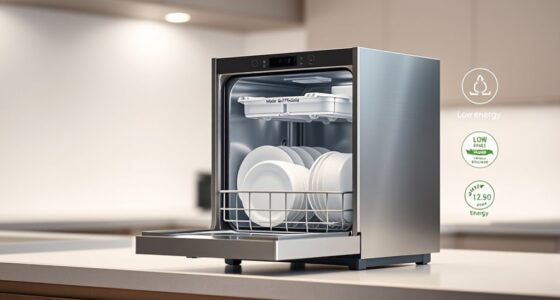To install a countertop dishwasher, start by checking that your sink and faucet can connect easily with the hose or diverter valve. Make sure the power outlet is nearby and properly grounded to avoid safety issues. Position the unit close to your water supply and drain to prevent kinks or leaks. Secure all connections tightly and run a quick test cycle to confirm everything works smoothly. Keep these tips in mind, and you’ll guarantee a secure, efficient setup. Learn more to perfect your installation process.
Key Takeaways
- Ensure the countertop has enough space and stability for the dishwasher’s weight and size.
- Verify compatibility with your sink’s faucet and use a diverter valve for easy water connection.
- Position the unit close to an accessible electrical outlet within reach of the power cord.
- Connect the water inlet hose securely to prevent leaks, ensuring the faucet and diverter are properly installed.
- Test the installation with a quick run to check for leaks and proper operation before regular use.

Installing a countertop dishwasher is a practical way to save space and add convenience to your kitchen. Before you start, it’s important to consider the plumbing requirements. Most countertop dishwashers connect directly to your kitchen faucet, so check that your sink has a compatible hose connection. You may need a diverter valve that attaches to your faucet, allowing you to switch between washing dishes and regular use. Make sure the hose is long enough to reach comfortably from the dishwasher to your sink without tension or kinking. Also, verify that your sink area can accommodate the connection without blocking other fixtures or causing water leaks. Having a clear understanding of your plumbing setup helps prevent surprises once you start installation.
Next, pay attention to power outlet placement. Countertop dishwashers typically require a standard electrical outlet, so ensure there’s an accessible socket nearby. Ideally, the outlet should be within reach of the power cord without stretching or creating a tripping hazard. If your current outlet isn’t conveniently located, you might need to install a new one or use a grounded extension cord, but keep in mind that extension cords are not always recommended for appliances due to safety concerns. It’s best to have a dedicated outlet with proper grounding to avoid electrical issues. Also, check that the outlet is rated for the dishwasher’s power draw—most models operate on 120 volts. Ensuring proper power outlet placement not only makes installation smoother but also guarantees your dishwasher functions safely and efficiently.
When you’re ready to set everything up, position your countertop dishwasher close to the water supply and drain. Make sure the hoses aren’t kinked or stretched tight, which can cause leaks or impair performance. Connect the water inlet hose to your faucet or diverter valve, then secure the drain hose to a sink drain or a standalone drain pipe. Before plugging in, double-check that the power outlet is grounded and capable of supporting the appliance’s amperage. Once connected, turn on the water supply and run a quick test cycle to verify that there are no leaks and that the unit is functioning properly. This step helps catch any issues early and ensures your installation is secure. Additionally, selecting a high-quality projector can enhance your viewing experience once your setup is complete.
Frequently Asked Questions
Can Countertop Dishwashers Be Used With Hard Water?
Yes, you can use a countertop dishwasher with hard water, but hard water issues may cause mineral buildup over time. To prevent this, consider water softening solutions like installing a water softener or using descaling agents regularly. These steps help protect your appliance, improve cleaning performance, and extend its lifespan. Be proactive about managing hard water, and your countertop dishwasher will work efficiently and last longer.
What’s the Best Location for Installing a Countertop Dishwasher?
You should install your countertop dishwasher on a stable, flat surface in your kitchen space, ideally near the sink and power outlet. Place it at a comfortable countertop height, ensuring easy access and convenient water hookup. Avoid cramped areas or spots with limited ventilation. By choosing a location that maximizes your kitchen space and maintains countertop height, you’ll enjoy efficient operation and easy maintenance.
Do I Need a Plumber for Installation?
You don’t need a plumber for the installation process—unless you want it to turn into a plumbing emergency! Most countertop dishwasher setups are simple and straightforward, just requiring basic plumbing requirements like a faucet connection and power outlet. If you’re comfortable with minor DIY projects, you can handle it yourself. However, if your plumbing needs are complex or you’re unsure, calling a plumber guarantees everything’s done correctly and safely.
How Energy-Efficient Are Countertop Dishwashers?
Countertop dishwashers are quite energy-efficient, helping you save on utility bills with their low water and power consumption. Many models include eco-friendly features like eco cycles and energy-saving modes, which further enhance energy savings. By choosing an energy-efficient countertop dishwasher, you not only reduce your environmental impact but also enjoy the convenience of quick, effective cleaning without wasting resources. These appliances are a smart, eco-conscious addition to any kitchen.
Can I Connect a Countertop Dishwasher to My Existing Faucet?
Yes, you can connect a countertop dishwasher to your existing faucet. Check your plumbing requirements and faucet compatibility first; most countertop dishwashers come with a standard quick-connect adapter that fits common faucets. Make certain your faucet has a compatible spout and enough clearance. If needed, you might need an additional adapter or diverter valve. Always read the manufacturer’s instructions to confirm proper installation and avoid leaks.
Conclusion
Now that you’ve got the essential installation tips, you’re almost ready to enjoy the convenience of your countertop dishwasher. But remember, a few small details could make all the difference—are you prepared to double-check your connections? Ensuring everything’s perfect might reveal surprises, or perhaps a hidden challenge. Stay alert, and take your time. The final step could open a seamless experience or a minor hiccup. Are you ready to see what’s next?






